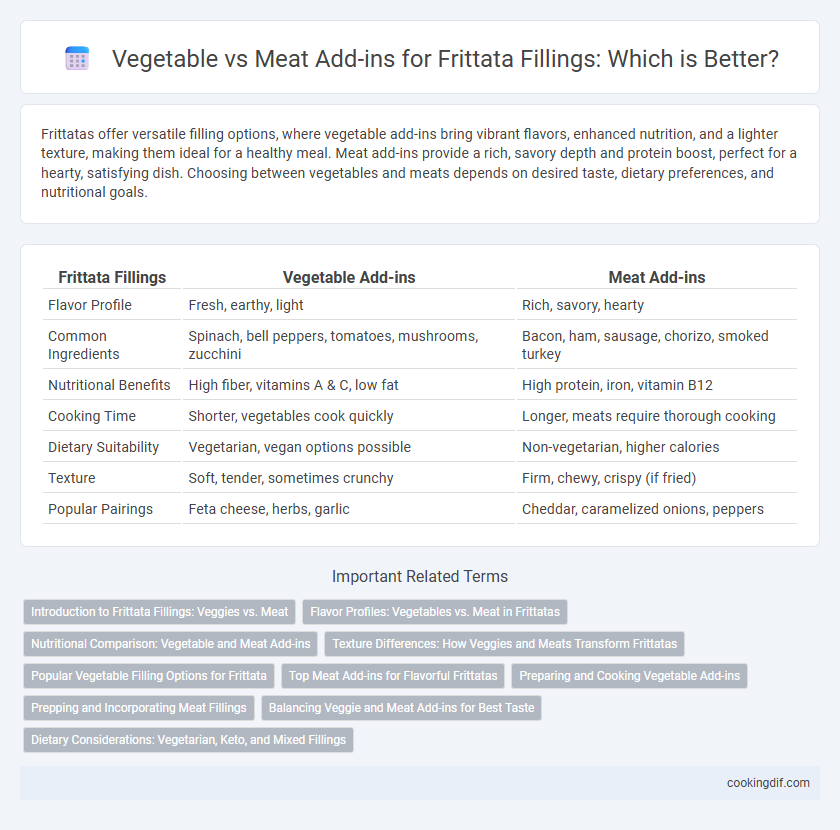Frittatas offer versatile filling options, where vegetable add-ins bring vibrant flavors, enhanced nutrition, and a lighter texture, making them ideal for a healthy meal. Meat add-ins provide a rich, savory depth and protein boost, perfect for a hearty, satisfying dish. Choosing between vegetables and meats depends on desired taste, dietary preferences, and nutritional goals.
Table of Comparison
| Frittata Fillings | Vegetable Add-ins | Meat Add-ins |
|---|---|---|
| Flavor Profile | Fresh, earthy, light | Rich, savory, hearty |
| Common Ingredients | Spinach, bell peppers, tomatoes, mushrooms, zucchini | Bacon, ham, sausage, chorizo, smoked turkey |
| Nutritional Benefits | High fiber, vitamins A & C, low fat | High protein, iron, vitamin B12 |
| Cooking Time | Shorter, vegetables cook quickly | Longer, meats require thorough cooking |
| Dietary Suitability | Vegetarian, vegan options possible | Non-vegetarian, higher calories |
| Texture | Soft, tender, sometimes crunchy | Firm, chewy, crispy (if fried) |
| Popular Pairings | Feta cheese, herbs, garlic | Cheddar, caramelized onions, peppers |
Introduction to Frittata Fillings: Veggies vs. Meat
Vegetable add-ins like spinach, bell peppers, and zucchini enhance frittatas with vitamins, fiber, and vibrant color, making them a nutritious and flavorful base. Meat add-ins such as bacon, sausage, or ham contribute protein, richness, and a savory depth that complements the eggs. Choosing between vegetables and meat fillings allows customization of texture and taste, catering to dietary preferences and nutritional goals.
Flavor Profiles: Vegetables vs. Meat in Frittatas
Vegetable add-ins in frittatas provide fresh, earthy, and sometimes sweet flavor profiles, with ingredients like spinach, bell peppers, and mushrooms enhancing moisture and texture without overwhelming the dish. Meat add-ins such as bacon, sausage, or ham introduce rich, savory, and smoky notes that deepen the overall taste complexity and add a satisfying umami element. Balancing vegetables and meats can create a harmonious blend of bright and robust flavors, making each bite layered and dynamic.
Nutritional Comparison: Vegetable and Meat Add-ins
Vegetable add-ins in frittatas provide higher fiber content, essential vitamins like A and C, and antioxidants, contributing to overall heart health and digestion. Meat add-ins offer a richer source of complete protein, iron, and B vitamins, supporting muscle repair and energy metabolism. Choosing between vegetables and meats affects calorie density, with vegetables generally lower in fat and calories compared to typical meat options like sausage or bacon.
Texture Differences: How Veggies and Meats Transform Frittatas
Vegetable add-ins in frittatas create a lighter, slightly crisp texture that contrasts with the creamy eggs, offering a fresh, tender bite, especially when using ingredients like bell peppers, zucchini, or spinach. Meat add-ins, such as bacon, sausage, or ham, add a denser, chewier texture and a rich, savory depth that intensifies the overall mouthfeel, providing a heartier and more substantial experience. Combining both vegetables and meats results in a balanced texture profile, where the soft, succulent vegetables complement the robust, meaty components, enhancing the frittata's complexity and satisfaction.
Popular Vegetable Filling Options for Frittata
Popular vegetable filling options for frittata include spinach, bell peppers, mushrooms, zucchini, and tomatoes, which provide vibrant colors and fresh flavors. These vegetables add essential nutrients such as vitamins A, C, and fiber, enhancing the frittata's health benefits. Compared to meat add-ins, vegetable fillings offer lower calories and cholesterol, making them ideal for vegetarian or lighter meal choices.
Top Meat Add-ins for Flavorful Frittatas
Top meat add-ins for flavorful frittatas include Italian sausage, crispy bacon, and spicy chorizo, each bringing rich, savory depth that enhances the egg base. Pancetta and smoked ham contribute a smoky, salty punch, while ground turkey offers a leaner protein option without sacrificing taste. Combining these meats with complementary vegetables like spinach and bell peppers creates a balanced, nutrient-rich filling packed with texture and bold flavor.
Preparing and Cooking Vegetable Add-ins
Vegetable add-ins for frittatas, such as bell peppers, spinach, and zucchini, require proper preparation like sauteing to remove excess moisture and enhance flavors, preventing a soggy texture. Cooking vegetables until tender before adding eggs ensures even distribution and better integration into the frittata. Incorporating well-prepared vegetable fillings results in a balanced, flavorful dish with vibrant colors and improved nutritional value.
Prepping and Incorporating Meat Fillings
Preparing meat fillings for frittatas requires thorough cooking to ensure safety and enhance flavor, with options like sauteed bacon, cooked sausage, or shredded chicken. Vegetables generally need to be pre-cooked or sauteed to remove excess moisture, but meats often add richness and protein that complement the egg base. Incorporating well-seasoned, fully cooked meats evenly distributes flavor and texture, creating a balanced and hearty frittata.
Balancing Veggie and Meat Add-ins for Best Taste
Balancing vegetable and meat add-ins in a frittata enhances both flavor and texture, creating a harmonious dish. Combining colorful vegetables like bell peppers, spinach, and mushrooms with savory meats such as bacon, sausage, or ham ensures a rich, well-rounded taste. Using equal portions of vegetables and meat helps maintain a nutritious profile while delivering satisfying, layered flavors in every bite.
Dietary Considerations: Vegetarian, Keto, and Mixed Fillings
Vegetable add-ins such as spinach, bell peppers, and mushrooms provide essential nutrients and fiber, making them ideal for vegetarian and keto-friendly frittatas due to their low carbohydrate content and high vitamin profile. Meat add-ins like bacon, sausage, and ham offer rich protein and fat, supporting ketogenic dietary goals while adding robust flavor, though they exclude vegetarian options. Combining vegetables and meats allows for balanced mixed fillings that satisfy diverse preferences while maintaining key macronutrient ratios important in keto and low-carb diets.
Vegetable Add-ins vs Meat Add-ins for fillings Infographic

 cookingdif.com
cookingdif.com